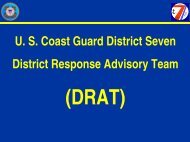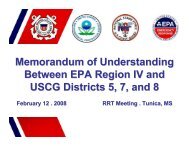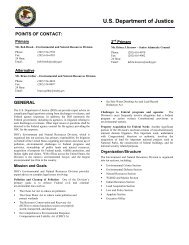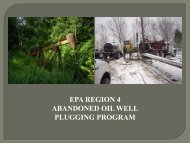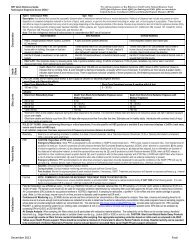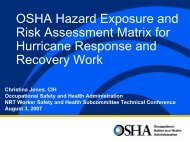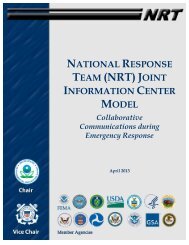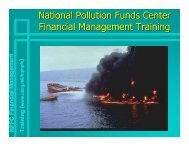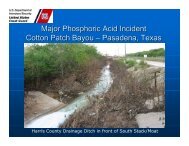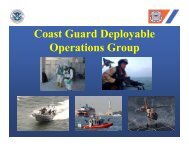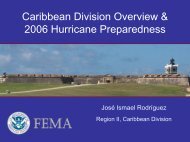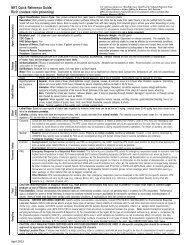Most aquatic organisms have the ability to metabolize and depurate petroleum hydrocarbons. Existing datademonstrate that complete depuration occurs once the source of the contamination is removed. It is unlikely thatsignificant amounts of petroleum hydrocarbons will be accumulated by pelagic organisms during a dispersantapplication because of the short duration and low concentration expected in the water column. Under suchconditions, any accumulated petroleum hydrocarbons should be rapidly eliminated. Marine food chainbiomagnification does not occur because vertebrate predators, including sea turtles and sea birds, readily metabolizeand depurate hydrocarbons from their tissues. Most marine organisms also metabolize and excrete the surfactants indispersants. Metabolism of surfactants is rapid enough that there is little likelihood of food chain transfer frommarine invertebrates and fish to predators (Neff, 1990).Marine finfish, for example, take up petroleum hydrocarbons from water and food. The compounds induce thehepatic Mixed-Function-Oxidase (MFO) system and within a few days following exposure, aromatic hydrocarbonsare oxygenated to polar metabolites and excreted. For this reason, most fish do not accumulate and retain highconcentrations of petroleum hydrocarbons and so are unlikely to transfer them to predators. The fish may be taintedwith metabolites bound to tissue macromolecules, but these metabolites are so reactive that it is unlikely that theywould be released in a toxic form during digestion by the consumer and so would not pose a serious risk (Neff,1990).Pelagic invertebrates become contaminated by assimilating hydrocarbons directly from seawater and by ingesting oildroplets and tainted food. Crustaceans can transform aromatic hydrocarbons to polar metabolites that may beexcreted or bound to tissues. For a few days or weeks, unmetabolized or metabolized hydrocarbons in crustaceansand other invertebrates could be transferred to predators. Considering the low concentrations and short duration ofexposure to dispersed oil, as described earlier, it is unlikely predators would ingest enough oil through consumptionof contaminated aquatic invertebrates to result in adverse affects.Analysis of AlternativesEmergency AuthorizationThe proposed action pre-authorizes the FOSC to use dispersants as a first-stage response technique in specifiedzones as described above. The alternative is to require the FOSC to seek CRRT authorization to use dispersants inthese areas on a case-by-case basis at the time of an oil spill emergency. The limited "window of opportunity" forthe most optimal and effective use of dispersants following an oil spill occurs very early -- usually within the firstfew hours. Without pre-authorization to permit rapid response and mobilization of the necessary equipment, thedelay for case-by-case CRRT approval would realistically eliminate dispersants as a response option. Moreover, inthe absence of pre-authorization, spill response organizations are unlikely to invest in the equipment and trainingnecessary to apply dispersants due to the low probability that authorization would be issued in time to employ thetechnique. Pre-authorization enabling timely use of dispersants under appropriate conditions in the designated zonesprovides greater protection for listed species and critical habitat than does case-by-case authorization at the time of aspill emergency.Mechanical RemovalMechanical containment and removal will remain the preferred response tool for most oil spills, which usually areclose to shore in areas where other response options are unlikely to be approved. Experience has shown, though,that mechanical response often cannot adequately deal with very large spills offshore. Performance of mechanicalmethods can be severely limited by weather and oceanic conditions and by the nature of the oil slick. Booms andskimmers are of limited use even in moderate seas and are usually effective only at slow current (less than 1 knot)and low wave heights (less than 2 meters). Consequently, mechanical recovery rates are often poor. Even undercalm conditions, use of mechanical equipment alone to deal with large spills in which oil rapidly spreads over largeareas may not be feasible. For these reasons, dispersant application is an important complementary spill responsetechnique and should be included along with other techniques as on option in developing the appropriate responsestrategy. Under this regional policy, use of dispersants will be considered when and where physical removal isimpossible or insufficient for protecting natural resources, including listed species.
In-Situ BurningThe Caribbean Regional <strong>Response</strong> <strong>Team</strong> approved a policy, effective May 3, 1996, pre-authorizing use of in-situburning in response to oil discharges within the jurisdiction of the Caribbean RRT. In-situ burning is an oil spillresponse technique that can quickly remove large volumes of oil from the water surface by igniting oil that is towedaway from the main slick in fire-resistant boom. Though in-situ burning is a highly useful and important responseoption, there are some differences in the range of oil and weather conditions under which in-situ burning anddispersants are effective. For example, in-situ burning is not effective once oil has spread to less than about twomillimeters thick. Also, if winds are blowing shoreward toward populated areas or sensitive environments, in-situburning is unlikely to be employed due to concerns about potential effects of the smoke plume. Under conditions forwhich in-situ burning would not be effective or creation of a smoke plume is deemed unacceptable, dispersants maybe a more viable option.No ActionAnother alternative is not attempting to remove released oil from the water surface, potentially allowing the oil towash ashore. The oiled shoreline could be cleaned or allowed to recover naturally. Due to the importance ofnearshore and shoreline habitat to a variety of organisms and the difficulty of cleaning oiled shorelines withoutinflicting further injury, this alternative is considered the least desirable from several perspectives, includingprotection of listed species and critical habitat. Unrecovered oil poses a high risk of exposure and injury to wildlife,especially sea birds, marine mammals, and intertidal organisms. Cleaning and rehabilitation of oiled wildlife,particularly marine mammals, have had limited success and release of rehabilitated animals creates a risk ofintroducing disease into the wild population.ConclusionsThe purpose of dispersants, used alone or in conjunction with other open-water spill response techniques, is toquickly remove spilled oil from the water surface, thereby reducing exposure to wildlife and preventingcontamination of sensitive nearshore and shoreline habitat. Under appropriate conditions, dispersants can reduceenvironmental impacts from oil spills, including injury to listed species and critical habitat. Dispersant application isnot likely to adversely affect listed species beyond the potential effects of the spilled oil or add to the cumulativeenvironmental stresses currently acting on the species. In a previous U.S. Fish and Wildlife review of a BiologicalAssessment of the effects of the Region IV Regional <strong>Response</strong> <strong>Team</strong> (RRT IV) Dispersant Use Policy, USFWSconcurred with the U.S. Coast Guard’s determination that the proposed dispersant pre-authorization, was not likelyto adversely affect the listed species under the responsibility of the Service. All listed species considered in thisBiological Assessment for the Caribbean RRT Letters of Agreement were also considered in the BiologicalAssessment for the RRT IV Dispersant Use Policy. Though patterns of behavior and habitat use may vary amongpopulations of a species distributed in different geographic areas, these differences for the listed species consideredin this Biological Assessment are not expected to be significant enough to result in a higher likelihood of impactfrom dispersant pre-authorization in the Caribbean RRT area of responsibility than in the RRT IV jurisdiction.The parties to the Caribbean Letters of Agreement pre-authorizing dispersants as an oil spill response technique inthe designated areas conclude that this action is not likely to adversely affect the listed species or critical habitatpresent in the area under consideration. We request that the U.S. Fish and Wildlife Service concur with thisconclusion and agree that formal consultation under Section 7 of the Endangered Species Act is not necessary.Consultation will be re-initiated if additional information not previously considered becomes available indicatingadverse effects to listed species or critical habitat from the identified action.ReferencesAllen, A.A. and R.J. Ferek. 1993. Advantages and disadvantages of burning spilled oil. In Proceedings of the 1993International Oil Spill Conference, March 29 – pril 1, 1993, Tampa, FL. pp. 765-772.Collazo, J.A. and E.E. Klaas. 1986. Recovery Plan for the Brown Pelican, Pelicancus occidentalis occidentalis inPuerto Rico and the U.S. Virgin Islands. U.S. Fish and Wildlife Service, Atlanta, GA. pp. 1-15.
- Page 2 and 3: UPDATES AND CHANGESCHANGE OR UPDATE
- Page 6 and 7: CARIBBEAN REGIONAL RESPONSE TEAMPOL
- Page 9 and 10: SECTION IPurposeThis policy provide
- Page 11 and 12: 2. YELLOW ZONE - WATERS REQUIRING C
- Page 13 and 14: SECTION IIIProtocolsTHE FOLLOWING R
- Page 15 and 16: APPENDICES
- Page 17 and 18: Caribbean Regional Response TeamDis
- Page 19 and 20: Caribbean Regional Response TeamDis
- Page 21 and 22: Caribbean Regional Response TeamDis
- Page 23 and 24: Caribbean Regional Response TeamDis
- Page 25 and 26: Caribbean Regional Response TeamDis
- Page 27: Caribbean Regional Response TeamDis
- Page 30 and 31: Caribbean Regional Response TeamDis
- Page 32 and 33: CommanderSeventh Coast Guard Distri
- Page 34 and 35: mile from any reef which is less th
- Page 36 and 37: high exposure levels, volatile hydr
- Page 38 and 39: a few days or weeks, unmetabolized
- Page 40 and 41: 1990. Geraci, J.R. and D. J. St. Au
- Page 42 and 43: CommanderSeventh Coast Guard Distri
- Page 44 and 45: Biological Assessment of Effects on
- Page 46 and 47: The dispersed oil droplets, ranging
- Page 48 and 49: Sea TurtlesSea turtles can be expos
- Page 52 and 53: Ernst, C.H., J. Lovich, and R.W. Ba
- Page 54 and 55: Appendix IIIDispersant Use Monitori
- Page 56 and 57: Dispersant Use Monitoring Program w
- Page 58 and 59: APPENDIX IVDispersant Use Decision
- Page 60 and 61: - dispersant composition;- water sa
- Page 62 and 63: For Puerto Rico:1) the waters are n
- Page 64 and 65: DOCUMENTATION/APPLICATION FORM FORD
- Page 66 and 67: 2. Type of aircraft used __________
- Page 68 and 69: Letter of AgreementCommonwealth of
- Page 70 and 71: 300. SCOPE301. The USCG, USEPA, USD
- Page 72 and 73: debriefing will gather information
- Page 74 and 75: LETTER OF AGREEMENTON LIMITED USE O
- Page 76 and 77: LETTER OF AGREEMENTON LIMITED USE O
- Page 78 and 79: minimize substantial threat to publ
- Page 80 and 81: Appendix VIDispersant Use Operation
- Page 82 and 83: APPENDIX VIDispersant Use Operation
- Page 84 and 85: APPENDIX VI TABLE OF CONTENTSSECTIO
- Page 86 and 87: ICS DISPERSANT USE ORGANIZATIONAL R
- Page 88 and 89: DISPERSANT USE DECISION / IMPLEMENT
- Page 90 and 91: DISPERSANT APPLICATION PLATFORM CAP
- Page 92 and 93: DISPERSANT APPLICATION OPERATIONAL
- Page 94 and 95: DISPERSANT OPERATION PLAN CHECKLIST
- Page 96 and 97: GENERAL:OBSERVATIONS:PHOTOGRAPHY:In
- Page 98 and 99: Incident CommanderOperations Sectio
- Page 100 and 101:
DISPERSANT / APPLICATION FORM FROM
- Page 102 and 103:
DISPERSANT / APPLICATION FORM FROM
- Page 104 and 105:
[This page intentionally blank]
- Page 106 and 107:
• Comply with the dispersant use
- Page 108 and 109:
• Coordinates and is lead for any
- Page 110 and 111:
SPRAYER LOG SHEET(Completed by Spra
- Page 112 and 113:
OBSERVATION AIRCRAFT / VESSEL / "OB
- Page 114 and 115:
• The visibility of the dispersed
- Page 116 and 117:
Duration of FlightPreferred Altitud
- Page 118 and 119:
DISPERSANT OBSERVATION FINAL REPORT
- Page 120 and 121:
SITE SAFETY PLAN TEMPLATE FOR DISPE
- Page 122 and 123:
Adequate protection may be achieved
- Page 124 and 125:
(404)639-0615 (24 hr) (voice) 0655
- Page 126 and 127:
GENERIC SITE SAFETY PLAN FOR DISPER
- Page 128 and 129:
• From a safe distance (at least
- Page 130 and 131:
SAFE APPROACH TO A HELICOPTERAPPROA
- Page 132 and 133:
c. Optimum storage temperature rang
- Page 134 and 135:
X. ANALYSIS FOR HEAVY METALS AND CH
- Page 136 and 137:
wear long sleeve shirt, chemical re
- Page 138 and 139:
8. Solvents: CONFIDENTIAL9. Additiv
- Page 140:
___ rubber steel toe/shank safety b



